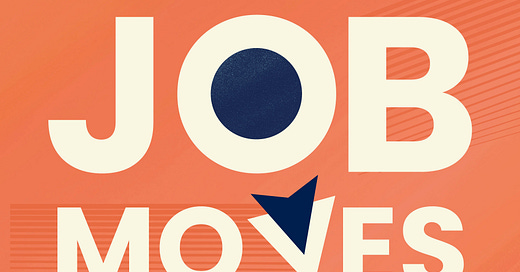Companies are using AI to decrease the number of entry-level roles they plan to hire. And with federal government layoffs and general uncertainty in the economy, graduating college students are facing an uphill climb as they enter the job market.
Bob Moesta and I see this dynamic playing out with the students we teach at Harvard and Northwestern Universities—so we wrote a piece for Time Magazine with our advice for newly-minted graduates.
Based on the research and coaching we’ve done with over 1,000 individuals looking for jobs (all documented in our national-bestselling book Job Moves: 9 Steps for Making Progress in Your Career!), we have found that there are approaches job seekers can use to find work—even in a challenging labor market. You can read the article, “How Recent Grads Can Get a Job—Even in a Challenging Labor Market,” here.
Our advice boils down to three points:
act like a customer;
build and use your network;
and learn how to embrace tradeoffs to make wise choices—because you’re not going to get it all.
We had a fourth piece of advice that didn’t make it into the piece, but I wanted to include it here. Because although the truth is that a job is better than no job, that doesn’t mean taking any job is without risks. Research by Burning Glass Institute shows that roughly half of students are underemployed in their first job—meaning they take a role that doesn’t require their college degree.
The risk of doing so is that five years later, nearly 90% of those who undermatch are still underemployed.
But what do you do if, in making tradeoffs, you find yourself needing to take a job that leaves you underemployed or unsatisfied?
Work at least one side hustle—for pay or as a volunteer.
The number of people today who have side hustles—roles in the gig economy, ideas for startups they’re tinkering with and the like—has grown significantly: 150 million workers in North America and Western Europe, according to one source.
And no wonder. It’s a great way to pile up real experiences, skills, knowledge, a network, and more so that you won’t fall into an underemployment trap long-term.
Managers also love hiring a go-getter who isn’t a prima donna and afraid to get their hands dirty and put in the time. Even better someone who can show them real results as they do so.
Who knows—one of your side hustles may end up being the prototype that leads to your next job.
AI Sludge Mucking Up the Job Search
The New York Times Dealbook Newsletter by Sarah Kessler last weekend was titled “Employers are Buried in A.I.-Generated Resumes: Candidates are frustrated. Employers are overwhelmed. The problem? An untenable pile of applications — many of them generated with the help of A.I. tools.”
Readers of the Future of Education of course aren’t surprised by this. Bob Moesta and I wrote about the phenomenon for Time Magazine back in March in the piece, “AI-Powered Tools May Make it Even Harder to Find a Job.”
Of course, rather than simply report on the challenge, we also offered predictions for what it would mean—and solutions to job seekers. Check it out if you missed it.
The insights in Job Moves are paying dividends.
Credential Clarity Starts Now
I’m tremendously excited that the Burning Glass Institute released its Credential Value Index earlier this month. The work is based off of the Education Quality Outcomes Standards (EQOS) Board that I co-founded while at Entangled in 2015. A decade later, the tool Burning Glass Institute built has exceeded my wildest hopes.
With more than 1.1 million post-secondary credentials across thousands of providers promising workers faster and cheaper avenues to advancing in their careers and boosting wages, it’s a wild west of choices right now. But all-too-often, the promise of these non-degree credentials (NDCs) disappoint.
The Burning Glass Institute analysis shows that while the right credential can be transformative, most fail to move the needle. Only about 1 in 8 credential earners see material wage gains that they wouldn't experience otherwise, they report. What’s more, results are hardly uniform across different providers.
That’s why their tool, the Credential Value Index, that allows individuals, companies, education providers, and policymakers to figure out the outcomes from different programs across a range of metrics is so important.
It’s a first-of-its-kind index and navigation tool that sheds light on the real-world outcomes of virtually every certification in America.
And it promises to only get better as more states work with them to improve the data and help individuals better navigate their educations and careers.
We’ll be off next week for the 4th of July — the 249th celebration of America’s independence. Enjoy.
And as always, thank you for reading, writing, and listening.





